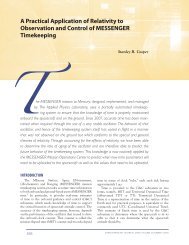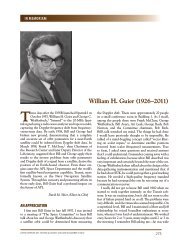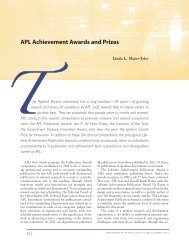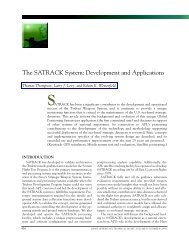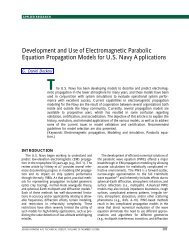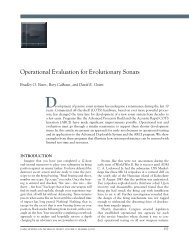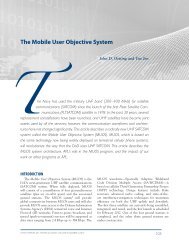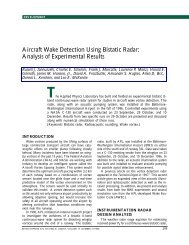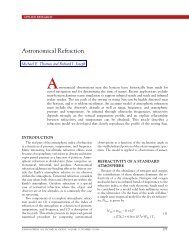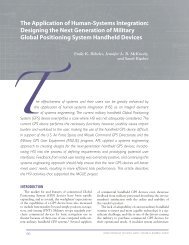Modern Electronic Packaging Technology - Johns Hopkins APL ...
Modern Electronic Packaging Technology - Johns Hopkins APL ...
Modern Electronic Packaging Technology - Johns Hopkins APL ...
You also want an ePaper? Increase the reach of your titles
YUMPU automatically turns print PDFs into web optimized ePapers that Google loves.
Figure 4. Plot showing the amount of substrate area required per lead and how this ratio<br />
varies with package style and total number of leads on the package. (DIP = dual-inline<br />
package, PLCC = plastic-leaded chip carrier, TSOP = thin small-outline package, QFP =<br />
quad flatpack, BGA = gall-grid array, PBGA = plastic BGA.)<br />
are made using thin gold or aluminum-alloy wire, typically<br />
with a diameter of 25 m (0.001 in.). Wire bonds<br />
are short, in the range of 1 to 3 mm (0.05–0.15 in.).<br />
Because they are so short and fragile, they impose additional<br />
packaging requirements. The frail wire bonds<br />
must be protected from damage and contamination,<br />
either by encasement in a rigid package or by molding<br />
in plastic.<br />
In the 1960s, IBM developed an alternative to wire<br />
bonding, now called flip-chip technology, which uses<br />
a solder joint to form an electrical, thermal, and<br />
mechanical connection to the substrate. The flip<br />
chip process produces higher yields and more rapid<br />
throughput than wire bonding. Additionally, it requires<br />
less space on a substrate than wire bonding and<br />
permits rework. As expected, these advantages also<br />
have their cost. Flip-chip technology is more challenging<br />
to implement for much of the electronics fabrication<br />
industry. The process requires special metallization<br />
during wafer fabrication. A barrier layer and a<br />
solderable top-layer metallization must be applied over<br />
the aluminum bond pads to provide a solderable surface<br />
and prevent aluminum dissolution in the solder.<br />
The barrier layer must be compatible with a solderable<br />
top layer, protect the surface of the semiconductor<br />
device from contamination, and prevent undesirable<br />
metallurgical reactions between the solderable layer<br />
and the device metallization. Flip-chip technology<br />
also requires a nonstandard substrate and processing<br />
of the substrate to reduce the size of the pads, vias,<br />
and traces. For these reasons, the cost of a flip chip<br />
is about $0.05 per connection versus less than<br />
MODERN ELECTRONIC PACKAGING TECHNOLOGY<br />
$0.001 per connection for wire<br />
bonding. 12<br />
The TAB method is an alternative<br />
to wire bonding and flip-chip<br />
bonding. It incorporates the bonding<br />
region with the lead frame fanout.<br />
A TAB structure typically begins<br />
as a thin laminate of copper on<br />
a polyimide film carrier. The conductors<br />
are etched out of the copper<br />
to form the electrical interconnection<br />
between the chip and the outside.<br />
The polyimide holds the copper<br />
conductors in place to facilitate<br />
rapid assembly. TAB technology<br />
uses several metallurgical coatings<br />
for conductors and bonding areas.<br />
Methods of connecting the TAB to<br />
the chip include thermocompression,<br />
thermosonic and ultrasonic<br />
bonding, and soldering. Joints may<br />
be bonded one at a time or simultaneously.<br />
The process is rapid<br />
and has found niches in certain<br />
markets. In low-volume markets (e.g., high-performance<br />
military electronics), TAB offers a highly reliable, highperformance<br />
interconnect method with a minimum of<br />
inductance and impedance. In high-volume markets,<br />
TAB offers a low-profile way to assemble circuits for<br />
applications such as digital watches and cameras.<br />
Wire bonding, flip-chip soldering, and TAB may<br />
require additional features for mechanical and thermal<br />
interconnection. In wire bonding, the back of the<br />
device must be attached to a substrate using an adhesive,<br />
gold-silicon eutectic solder or a glass compound.<br />
The adhesive is often filled with silver or gold powder,<br />
making it electrically conductive and enhancing thermal<br />
conductivity. Because of the large surface area involved,<br />
device attachment provides a good thermal<br />
connection and high mechanical strength.<br />
Flip-chip technology does not require additional mechanical<br />
attachment because the solder joints provide<br />
sufficient support to withstand shock and vibration<br />
forces. The flip-chip solder joints, by themselves, can<br />
dissipate considerable device heat. If further measures<br />
are needed to remove heat, two options are available.<br />
In the most demanding applications, heat may be removed<br />
from the back side of the flip chip through<br />
conduction by using a small block of water-cooled copper<br />
such as that used in the IBM thermal control<br />
module. 13 The second option is to fill the gap between<br />
the flip chip and the substrate with an encapsulant,<br />
called “underfill,” to increase thermal conductivity.<br />
This underfill also provides environmental protection<br />
to the device circuitry and improves the thermal fatigue<br />
resistance of the solder joints.<br />
JOHNS HOPKINS <strong>APL</strong> TECHNICAL DIGEST, VOLUME 20, NUMBER 1 (1999) 27




